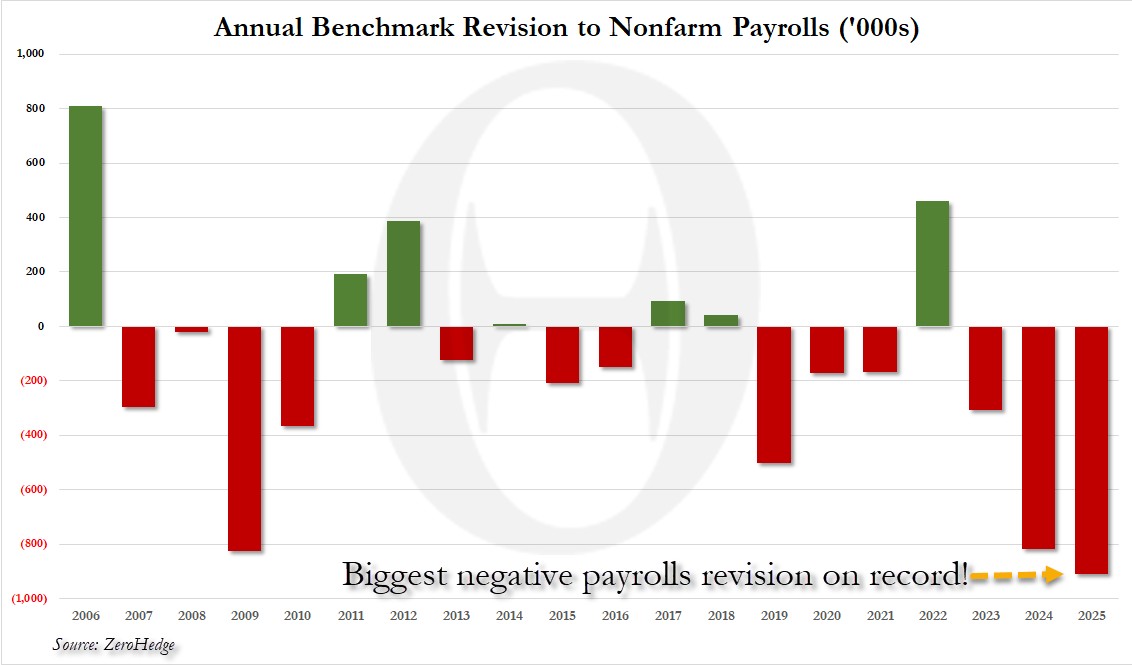
The annual revision of the U.S. non-farm payrolls is worse than expected, revised down by 910,000, increasing pressure on the Federal Reserve to cut interest rates

根據美國政府週二公佈的初步基準修訂數據,截至 3 月的一年間的非農就業人數下修 91.1 萬,相當於每月平均少增加近 7.6 萬。這是自 2000 年以來的最大下修。更多的就業市場疲軟跡象將為特朗普推動美聯儲降息的論點增添新理由。本次年度修正加劇了人們對經濟健康狀況的擔憂,也讓勞工統計數據的可信度受到質疑。數據發佈後,黃金先漲後跌,美債收益率隨後走高。
美國截至 3 月的一年間就業增長遠不如此前報告所示,這加大了美聯儲降息的壓力。
根據美國政府週二公佈的初步基準修訂數據,截至 3 月的一年間的非農就業人數下修 91.1 萬,相當於每月平均少增加近 7.6 萬。按 1.71 億勞動力總數計算,本次修訂約佔 0.6%。這是自 2000 年以來的最大下修幅度。

市場對本次數據下修的預期為 68.2 萬。在本次數據公佈前,多位經濟學家表示,截至今年 3 月的一年裏,美國就業人數可能會被大幅下修近 80 萬。美國財長貝森特也預警年度就業可能下修多達 80 萬。然而,最終的下修幅度比市場普遍預期的還要糟糕。
分行業來看,幾乎所有行業的就業人數均被下調。下修幅度最大的行業包括:休閒和酒店業–17.6 萬,專業和商業服務業–15.8 萬,零售貿易–12.62 萬,製造業的就業人數也顯著下調。只有交通運輸與倉儲以及公用事業小幅上調。幾乎所有修訂都集中在私營部門;政府部門的就業數據則下修了 3.1 萬。
在該報告發布之前,美國政府的數據顯示,截至 3 月的一年間,僱主在未經過季節性調整的情況下共新增近 180 萬個就業崗位,平均每月增加 14.9 萬個。
本次非農年度修正報告涵蓋的大部分時間段在特朗普就任美國總統之前,表明該國就業形勢在他開始對美國貿易伙伴加徵關税之前就已經惡化。週二公佈的數據還會在 2026 年 2 月 BLS 發佈最終基準修訂時進一步調整。
上一年的非農基準修訂涵蓋截至 2024 年 3 月的 12 個月,最初下調總數為 81.8 萬,後來在 2025 年 2 月修正為 59.8 萬,仍然是自 2009 年以來最大的一次下調。
非農數據修正
非農年度基準修訂與月度調整不同,其範圍要廣得多。月度調整主要來自 BLS 新增的調查數據;而年度基準修訂則基於季度就業與工資普查,以及税務數據,這些數據提供了幾乎全面的重新計算,而不僅僅是月度報告的增量修正:
BLS 的每月就業報告是基於兩項調查匯總的。基準修訂涉及薪資就業人數,這些數據通過企業調查獲得;修訂不會影響失業率,因為失業率是通過家庭調查得出的。
每年一次,BLS 會將 3 月的就業人數基準化,參照一種更準確但滯後性更強的數據來源——季度就業與工資普查(QCEW)。該數據基於各州失業保險税記錄,涵蓋了美國幾乎所有的就業崗位。
雖然非農就業的基準修訂每年都會進行,但今年受到更多關注,因為投資者和美聯儲觀察人士都在尋找跡象,判斷勞動力市場是否比先前預期放緩得更快。此次調整也波及到了政治領域,美國總統特朗普此前曾猛烈抨擊過對就業數據的修訂。
去年,在 2024 年初步基準修訂出現類似大幅下調後,特朗普也曾猛烈抨擊前美國總統拜登,質疑其政府的誠信和經濟業績。
本次數據修正的政治和經濟影響可能十分重大。更多的就業市場疲軟跡象將為特朗普推動美聯儲降息的論點增添新理由。本次非農就業的年度修正,不僅加劇了人們對經濟健康狀況的擔憂,也讓勞工統計數據的可信度受到質疑。
在今年 7 月非農就業報告疲軟、並伴隨大幅下修之後,特朗普解僱了時任 BLS 局長 Erika McEntarfer,並提名 Heritage Foundation 經濟學家 E.J. Antoni 接任。然而,8 月非農就業人數比 7 月更低,同時還伴隨修訂,將 6 月的總數下調為減少 1.3 萬個崗位,這是自 2020 年 12 月以來的首次負增長。
需要説明的是,儘管特朗普批評修訂,但無論是月度修訂還是基準修訂,都是在獲得更多數據後對估算值進行更新的常規流程。近年來修訂幅度大於往常,一些經濟學家將此歸因於疫情後特殊的經濟動態。幾位經濟學家表示,就業初值數據可能受到多種因素影響,包括企業開張和關閉的調整,以及如何統計無證移民工人。
近年來,大多數月度就業初值數據都比 QCEW 數據更強勁。一些經濟學家認為,這部分歸因於所謂的 “出生 - 死亡模型”——BLS 為反映企業開張與關閉的淨效應而做的調整,但在後疫情時代可能出現了偏差。
另一些人則認為還有一個原因:移民因素。由於 QCEW 基於失業保險記錄,而無證移民無法申請失業保險,因此該數據很可能剔除了初值中包含的大量無證工人。
市場解讀和反應
美國勞工統計局的這一調整表明,最近幾個月美國的勞動力市場放緩,其實是在經歷了一段已經降温的就業增長期之後發生的,這可能為美聯儲最早從下週開始的一系列降息奠定基礎。美聯儲主席鮑威爾最近承認,就業市場面臨的風險有所上升,而他的兩位同事在 7 月就傾向於降息。
週二的修訂數據本身並不能反映當前情況,因為這些數據最遠可追溯到一年半前。然而,最近幾個月的數據也在顯示勞動力市場走軟。6 月、7 月和 8 月三個月的月均新增非農就業僅為 2.9 萬個,低於維持失業率穩定所需的 “保本水平”。
交易員們普遍預計,美聯儲將在 9 月 17 日為期兩天的會議結束時宣佈降息。交易員們預計美聯儲在 12 月底前將利率總共下調 75 個基點的可能性超過 90%。過去一週,他們對降息的押注有所增加。
市場反應方面:
- 現貨黃金短線跳水,逼近 3640 美元,日內漲幅收窄至大約 0.3%,北京時間 22:00 發佈美國年度非農就業人數修正數據時還曾漲至 3674.27 美元。
- 美國 10 年期國債收益率自日低 4.0359% 反彈,重新逼近 4.07%,日內整體漲約 2.5 個基點;兩年期美債收益率自日低 3.48% 下方反彈,漲穿 3.51%。
- 標普 500 指數自日低 6494.64 點反彈,漲約 0.2%、刷新日高至 6507.10 點。

